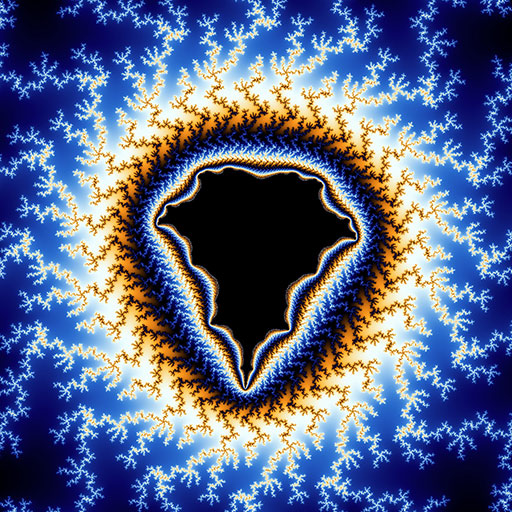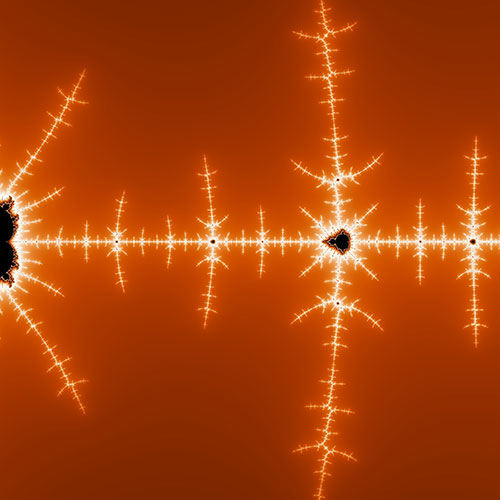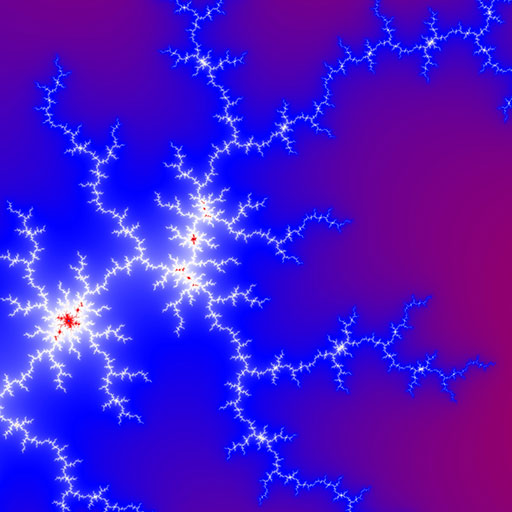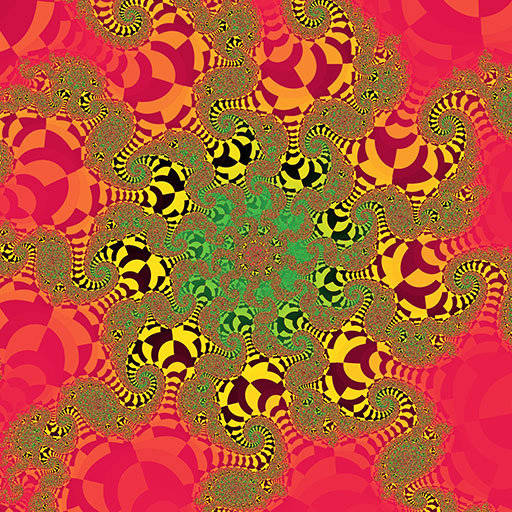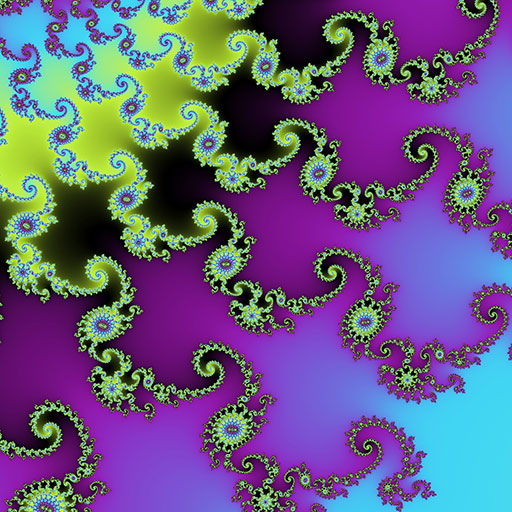Mandelbrot Fractals
Use our online Mandelbrot fractal explorer to create your own custom artwork.
Try it nowWhat is a Fractal?
Imagine that you have a slice of pizza and you want to measure it's circumference, but all you have is a 5" popsicle stick. You move the stick around the pizza, doing your best, and determine that it is 15" around. But the crust is a curve and the sides aren't perfectly straight, so this was only an approximation. Instead, lets use a 1" toothpick which can more closely trace the irregular shape of the pizza. We get a circumference of 16.33", but we are still cutting corners. Now, let's get a microscope and use a tiny 0.01" stick which can go into every crevice and trace every little bump that sticks out. What was a straight line with the toothpick is now a wiggly bumpy line that must be longer. We might now measure 17.878". Crank up the magnification and repeat - the circumference will keep getting longer.
This is the idea behind fractals. In a fractal image, you can keep zooming in and the complexity will keep increasing. Most fractals have some sort of self-similarity where you see the same shapes and patterns as you continue to zoom in.
Here are some classic images of fractals. The first one shows a fractal called a Koch snowflake. It is made by starting with a triangle and then taking each side and adding another protruding triangle. Repeat forever and you have a Koch snowflake.
The second one is a fractal tree where more and more branches are added to the ends of previous branches. This is how CGI trees are made in movies and video games. The last image shows the famous Mandelbrot set and demonstrates the characteristic of self-similarity as you zoom into it.
Additional Reading:
- Wikipedia: Fractals
- Amazon: Fractals: Form, Chance and Dimension by Benoit B. Mandelbrot
- Amazon: Fractals: On the Edge of Chaos by Oliver Linton
This page contains affiliate links. More info here.


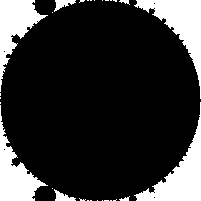
What is a Mandelbrot Fractal?
A Mandelbrot fractal is an image that is produced by recursively repeating a particular mathematical formula over and over again. This mathematical formula uses complex numbers so it's not a straight forward calculation. For each pixel in the image, the x and y coordinates are used to describe a complex number c = (x + y𝒾). That number is then squared over and over and over again.
z1 = c
z2 = z12 + c
z3 = z22 + c
z4 = z32 + c
...
At some point one of two things will happen:
- Diverge: The number will keep getting bigger and bigger. If the number grows past a certain limit, then it is said to have "escaped" because it will grow to infinity. When it escapes, we stop the recursive calculations but keep track of how many iterations it took before it escaped. This iteration count will be used to color the final image.
- Not Diverge: The number will converge or bounce around, but stay close to zero. At some point (called the iteration limit) we give up and stop calculating. The numbers that don't diverge are part of the Mandelbrot Set. These are typically colored black.
After doing this calculation for every pixel in the image, we can color the diverging pixels based on their iteration count and color the non-diverging pixels black to get the very famous and distinctive shape of the Mandelbrot set as shown here. The red box in these sample images shows where each has been zoomed in to produce the next image. Notice the self-similarity and recursive nature of the patterns.
Additional Reading:
- Wikipedia: Mandelbrot Set
- Amazon: The Fractal Geometry of Nature by Benoit B Mandelbrot
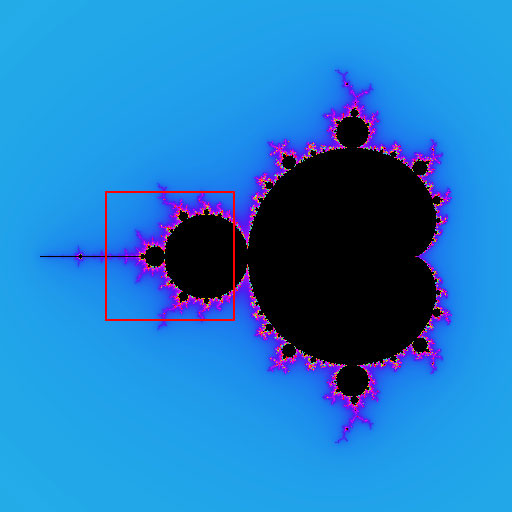
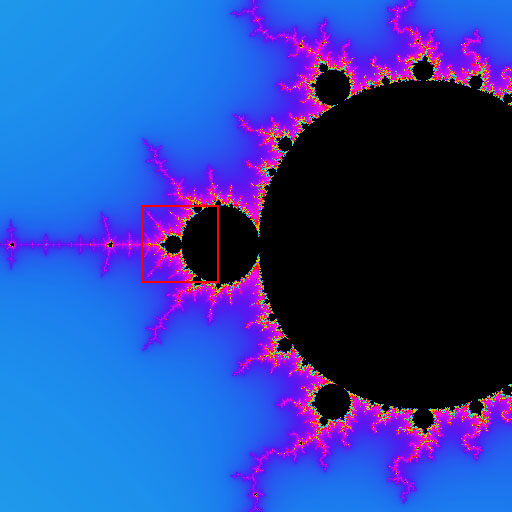

Properties of a Mandelbrot Fractal
Because the Mandelbrot fractal is so well known, some names have been given to certain parts of the fractal, and to certain shapes. As you explore the Mandelbrot set, you will start to recognize some of these shapes, and you will see how they repeat over and over again as you continue to zoom in to greater and greater depths.

Cardioid and Bulbs
The largest region has a distinctive cardioid shape and is called the "Main Cardioid". To the left of this is a circular shape called the "Primary Bulb". There are infinitely many smaller bulbs branching out from around the perimeter of the Mandelbrot set.

Seahorse Valley
If you zoom into the valley between the Main Cardioid and Primary Bulb you enter the Seahorse Valley with double spirals on the left and seahorses on the right.

Seahorse
This distinctive shape looks like a seahorse. It can be found throughout the Mandelbrot set.

Seahorse Tail
If you zoom into the seahorse's tail you can find an infinitely deep spiral made up of more seahorses, each with it's own infinitely deep tail made of even more seahorses.
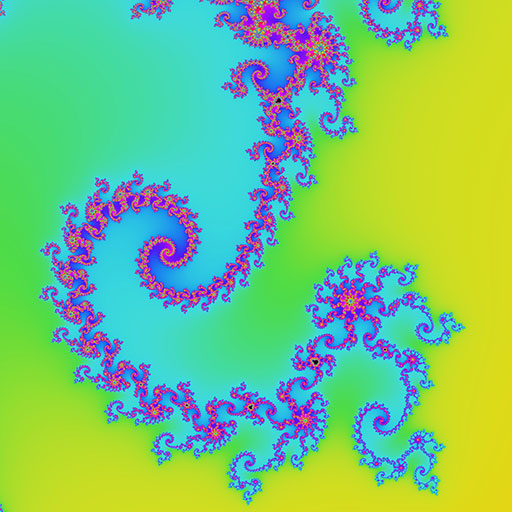
Double Spiral
Another common pattern found inside the Mandelbrot set is the double spiral which is infinitely deep. Branching off from the arms of the double spiral are more double spirals!

Antenna
The left side of the Mandelbrot shape is a long thin antenna with smaller antenna branching off of it. The more you zoom in, the more antenna you will find branching off of other antenna.
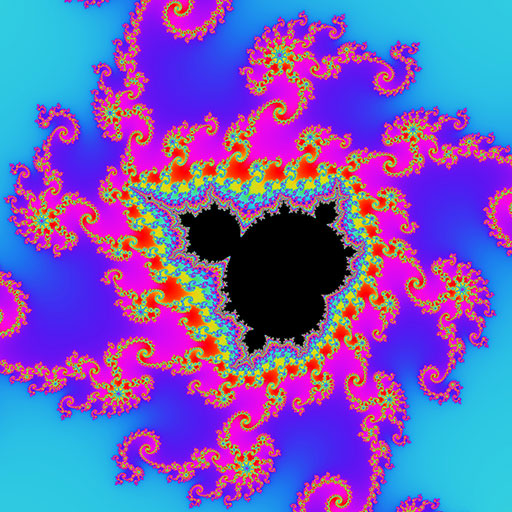
Minibrot
If you zoom in far enough, you are sure to find an exact copy of the entire Mandelbrot shape hidden within the original. These smaller, recursive copies are called Minibrots.
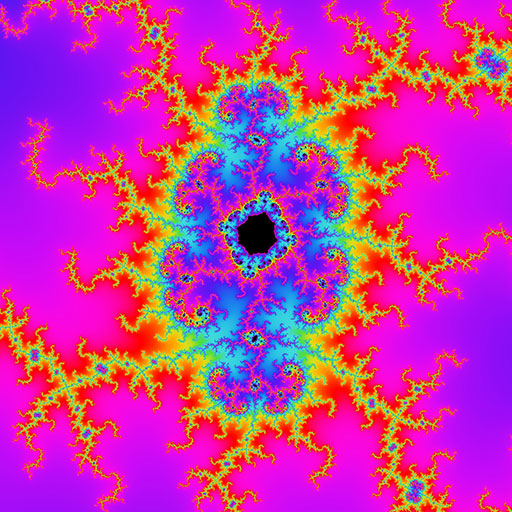
Islands
If you hunt for them, you can find isolated pockets of complexity called islands. Each island is a word unto itself.
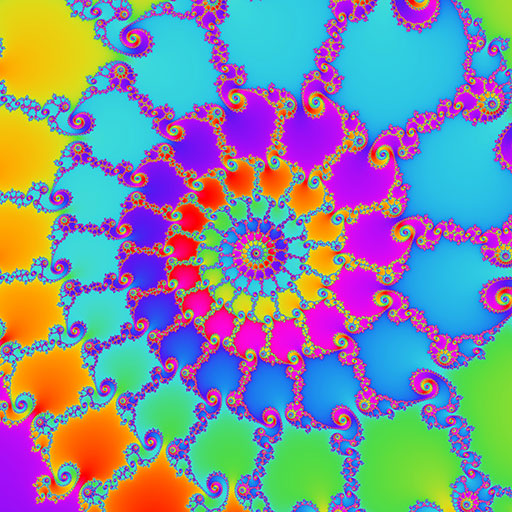
Spiral
Another common pattern that you may encounter while exploring the Mandelbrot set. These infinitely deep spirals come in a variety of styles and look very pretty when given a nice color palette.
